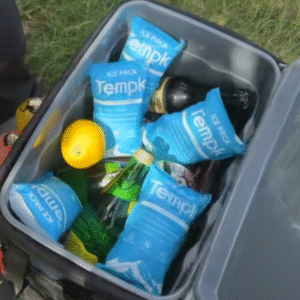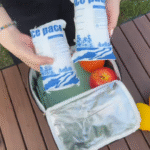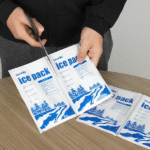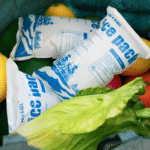Paquetes de hielo seco para envío al día siguiente: Garantizar una entrega segura y eficiente
El envío de mercancías perecederas y sensibles a la temperatura requiere precisión y cuidado, especialmente cuando se necesita una entrega rápida. Paquetes de hielo seco ofrecer una solución ideal para el envío al día siguiente, mantener los artículos congelados y seguros durante el tránsito. Esta guía cubrirá todo, desde los conceptos básicos del hielo seco., cómo empacar de manera efectiva, para comprender los requisitos reglamentarios involucrados en el envío con hielo seco.

-
Comprenda por qué el hielo seco es esencial para el envío al día siguiente
-
Aprenda a calcular la cantidad adecuada de hielo seco para su envío
-
Descubra los mejores métodos de embalaje y prácticas de seguridad.
-
Navegar por el panorama regulatorio del envío con hielo seco
-
Manténgase actualizado con 2025 tendencias en logística de cadena de frío
¿Qué hace que el hielo seco sea esencial para el envío al día siguiente??
El hielo seco es dióxido de carbono sólido (Co₂) que se sublima a una temperatura increíblemente baja de -78,5°C (-109.3°F), haciéndolo perfecto para mantener los productos fríos durante el envío. A diferencia del hielo tradicional, que se funde en agua y puede dañar los bienes, El hielo seco sublima directamente en gas, No dejando residuos atrás. Esta propiedad única ayuda a preservar la integridad de artículos sensibles., incluyendo productos farmacéuticos, alimento, y muestras biológicas.
Cómo funciona el hielo seco en el transporte marítimo
El hielo seco se sublima en gas CO₂ al absorber calor, mantener bajas temperaturas durante períodos prolongados. Cuando se empaqueta correctamente, puede mantener los productos congelados hasta por 72 horas. Esta característica es crucial para las entregas al día siguiente., Garantizar que artículos como alimentos congelados o vacunas lleguen a su destino en óptimas condiciones., sin riesgo de contaminación o desviaciones de temperatura.
| Tipo de producto | Ideal para envíos | Embalaje recomendado | Beneficios |
|---|---|---|---|
| Productos farmacéuticos | Vacunas, insulina, biológicos | Contenedores aislados, Cajas de espuma de poliestireno | Mantiene la eficacia y la estabilidad. |
| Alimentos Congelados | Helado, comidas congeladas, mariscos | Embalaje personalizado, refrigeradores aislados | Garantiza la calidad del producto. |
| Muestras biológicas | Sangre, tejido, muestras de laboratorio | Almacenamiento criogénico, embalaje especializado | Preserva la integridad de la muestra |
Cómo empacar para envío al día siguiente con hielo seco
El embalaje eficaz es esencial para garantizar que su envío de hielo seco se mantenga frío y seguro. Esto es lo que necesita saber sobre cómo empacar hielo seco para entrega al día siguiente.
1. Calcule la cantidad correcta de hielo seco
Para garantizar una refrigeración adecuada, debes calcular la cantidad correcta de hielo seco. Una pauta común es utilizar 5–10 libras de hielo seco por 24 horas de tiempo de envío. Esto variará según el tamaño del envío y la duración del tránsito.. Considere siempre agregar más para tener en cuenta retrasos inesperados o variaciones de temperatura..
Cálculo de ejemplo:
Por un 10 envío de libras, Necesitará aproximadamente entre 10 y 15 libras de hielo seco para un envío de 24 horas.. Para un envío más grande, la cantidad de hielo seco debe ajustarse en consecuencia.
2. Elija el embalaje correcto
El uso de contenedores aislados como cajas de poliestireno o hieleras de poliuretano es crucial para mantener la temperatura fría.. El embalaje debe permitir que el gas CO₂ escape a medida que el hielo seco se sublima.. Sellar el embalaje demasiado herméticamente puede provocar una acumulación peligrosa de presión., que puede hacer que el contenedor se rompa.
3. Etiquete y documente sus envíos
Los organismos reguladores como el Departamento de Transporte exigen un etiquetado adecuado. (PUNTO) y la Asociación Internacional de Transporte Aéreo (IATA). Los paquetes que contengan hielo seco deben estar claramente marcados con:
-
“Hielo seco” o “Dióxido de carbono, Sólido”
-
Y 1845 (código de materiales peligrosos)
-
Peso del hielo seco en kilogramos.
-
Nombre y dirección del remitente y del destinatario
Además, incluir un Clase 9 Peligros varios etiqueta si es necesario.
4. Utilice transportistas confiables
Elija transportistas que tengan experiencia en el manejo de envíos de hielo seco.. Los principales proveedores de logística como Fedex, Unión Postal Universal, y USPS ofrecer servicios de entrega al día siguiente con el embalaje y la documentación adecuados. Asegúrese de verificar sus requisitos y límites de peso., ya que las regulaciones pueden diferir según el transportista.
Mejores prácticas y errores comunes que se deben evitar
Errores comunes que se deben evitar en el envío con hielo seco
-
Embalaje inadecuado: No utilizar envases aislados o recipientes herméticos puede provocar que el hielo seco se sublime demasiado rápido..
-
Cantidad incorrecta de hielo seco: Usar muy poco hielo seco produce un enfriamiento inadecuado, mientras que usar demasiado puede causar presión excesiva en el paquete.
-
Embalaje sin ventilación: El hielo seco libera gas CO₂, lo que puede aumentar la presión si el paquete no está adecuadamente ventilado, causando problemas de seguridad.
-
Incumplimiento de las regulaciones: El hielo seco se considera peligroso, por lo que es fundamental cumplir con todas las normas de etiquetado y documentación para evitar retrasos o sanciones..
Ejemplo del mundo real
Una empresa farmacéutica utilizó con éxito la cantidad adecuada de hielo seco y envases aislados para enviar dosis críticas de vacunas durante la noche. El envío llegó sano y salvo manteniendo la temperatura requerida., demostrando cómo una planificación cuidadosa y un embalaje adecuado pueden evitar el deterioro y garantizar la satisfacción del cliente..
2025 Tendencias en el envío de hielo seco
En 2025, La industria de la logística de la cadena de frío está evolucionando., con nuevas tecnologías y consideraciones ambientales que dan forma al futuro del transporte con hielo seco.
Tendencias clave:
-
Enfoque de sostenibilidad: Las empresas están explorando alternativas y prácticas ecológicas para reducir las emisiones de CO₂ asociadas con la producción y el uso de hielo seco..
-
Soluciones de embalaje inteligentes: Las tecnologías de embalaje avanzadas proporcionarán un control de temperatura más preciso y un seguimiento de los envíos en tiempo real..
-
AI y automatización: Se está integrando inteligencia artificial para optimizar el uso del hielo seco, predecir las tasas de sublimación, y mejorar la eficiencia en las operaciones de la cadena de frío.
Tecnologías emergentes
-
Materiales de cambio de fase (PCM): La combinación de hielo seco con PCM ayuda a extender el tiempo de enfriamiento y al mismo tiempo reduce el impacto ambiental..
-
Aprendizaje automático: Sistemas de inteligencia artificial que predicen cambios de temperatura y ajustan las cantidades de hielo seco en tiempo real para mejorar la eficiencia y reducir el desperdicio..
Preguntas frecuentes
Q1: ¿Cuánto dura el hielo seco durante el envío??
El hielo seco suele durar entre 18 y 24 horas en tránsito, dependiendo del embalaje, cantidad de hielo seco, y condiciones ambientales. Enfriar previamente sus productos y utilizar aislamiento de alta densidad ayudará a ampliar su eficacia..
Q2: ¿Puedo enviar hielo seco a nivel internacional??
Sí, El hielo seco se puede enviar internacionalmente.. Sin embargo, Las regulaciones específicas varían según el país., y es posible que se requiera documentación adicional. Siempre consulte con su transportista las pautas de envío internacional..
Q3: ¿Es seguro manipular hielo seco??
Sí, El hielo seco es seguro cuando se manipula correctamente.. Utilice siempre guantes y gafas protectoras para evitar la congelación y garantice una ventilación adecuada para evitar la acumulación de CO₂..
Conclusión y recomendaciones
El hielo seco es una solución confiable y eficiente para el envío de productos sensibles a la temperatura, especialmente cuando se necesita una entrega rápida. Calculando la cantidad correcta de hielo seco, seleccionar el embalaje adecuado, y cumplir con los requisitos reglamentarios, Puede asegurarse de que sus envíos lleguen de forma segura y puntual..
Pasos procesables:
-
Calcule sus necesidades de hielo seco según el peso y el tiempo de tránsito de su envío.
-
Elija el embalaje adecuado que permita la liberación de gas y proporcione un aislamiento adecuado.
-
Cumplir con las regulaciones del transportista e incluir la documentación necesaria para un tránsito fluido.
-
Seguimiento de envíos para monitoreo en tiempo real y tranquilidad.
Acerca de Tempk
Tempk es un proveedor líder de soluciones de envasado con temperatura controlada. Nuestros productos, incluyendo bolsas de hielo seco, mezclas de PCM, y materiales aislantes avanzados, están diseñados para garantizar que sus envíos perecederos se entreguen de forma segura y puntual. Priorizamos la sostenibilidad y la innovación para satisfacer las necesidades cambiantes de nuestros clientes en el sector alimentario., farmacéutico, e industrias biotecnológicas.
Contáctenos: Para obtener asesoramiento de expertos sobre envíos con hielo seco, póngase en contacto con nuestro equipo hoy!























